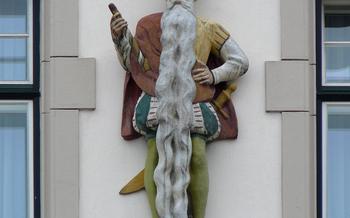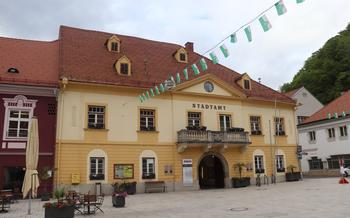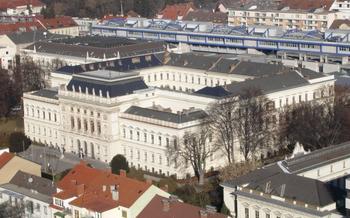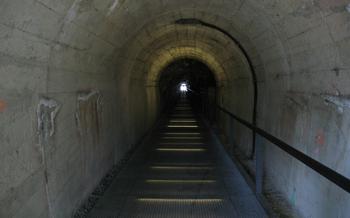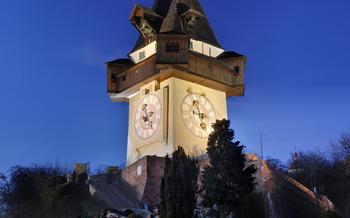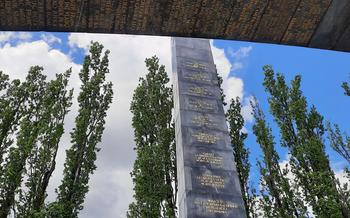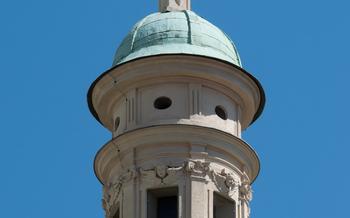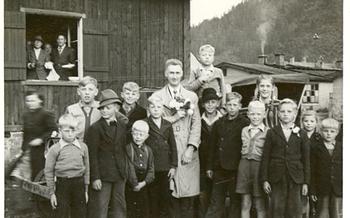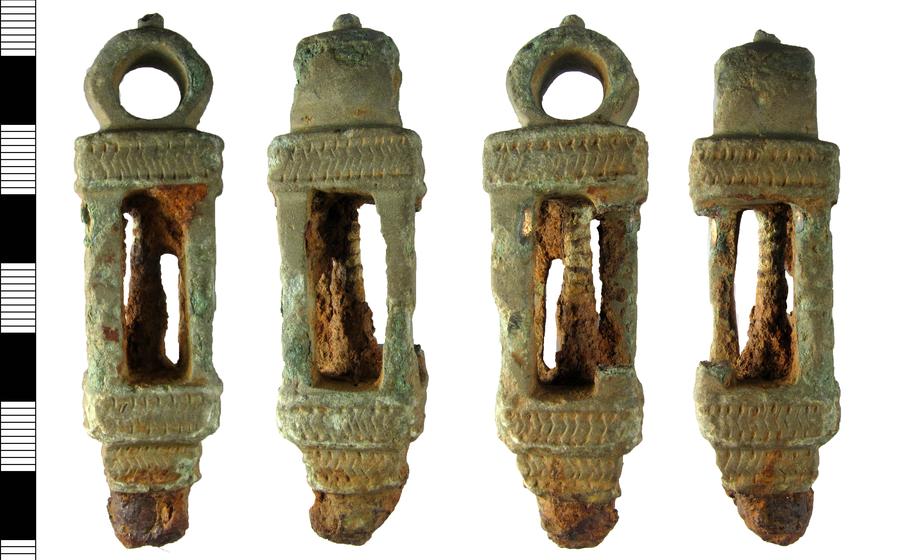
Schell Collection (Key and Lock Museum)
- Graz: A Cultural Gem in Austria
- The Schell Collection: A Treasure Trove of Locks and Keys
- Exploring the Museum's Exhibits
- Unveiling the Stories Behind the Locks
- Interactive Workshops and Demonstrations
- The Art of Locksmithing
- Unique Souvenirs and Gifts
- Accessibility and Visitor Information
- Educational Programs and School Visits
- Temporary Exhibitions and Special Events
- Historic Locksmiths of Graz
- Graz's Architectural Heritage and Locks
- Locks and Legends of Graz
- Modern Applications of Locksmithing
- Insider Tip: Culinary Delights Await
Graz: A Cultural Gem in Austria
Graz, the capital of Styria, Austria, is a city steeped in history, culture, and natural beauty. As the former residence of the Habsburg dynasty, Graz boasts a rich architectural heritage, including the iconic Schloss Eggenberg, a UNESCO World Heritage Site. The city's vibrant arts and culture scene comes alive with numerous festivals, museums, and theaters, attracting visitors from around the world. Graz is also surrounded by stunning landscapes, with the Styrian Alps and beautiful lakes just a short distance away, inviting visitors to explore the region's natural wonders.
The Schell Collection: A Treasure Trove of Locks and Keys
The Schell Collection, named after its founder August Schell, is a fascinating museum that houses a remarkable collection of over 30,000 keys and locks from around the world. This unique collection offers a glimpse into the cultural, historical, and functional significance of locks and keys throughout the ages.
August Schell, a locksmith by profession, began collecting locks and keys as a hobby in the early 1900s. His passion for these intricate mechanisms led him to amass an impressive collection that spanned different cultures, eras, and styles. In 1954, Schell decided to share his collection with the public, and the Schell Collection was opened to visitors in Graz, Austria.
The museum's exhibits are organized into thematic sections, showcasing a wide variety of locks and keys. From ancient Egyptian wooden locks to intricate medieval padlocks, the collection offers a glimpse into the evolution of lock-making techniques and designs. Visitors can also admire beautifully crafted keys and locks from Asia, Africa, and the Americas, each telling a unique story about the cultures that created them.
Beyond their functional purpose, locks and keys have often held symbolic and cultural significance. The Schell Collection highlights these aspects through interactive displays and multimedia presentations. Visitors can learn about the role of keys in religious rituals, the use of locks as symbols of power and authority, and the superstitions and beliefs associated with keys and locks in different cultures.
The Schell Collection is not just a museum; it's a celebration of human ingenuity and craftsmanship. It invites visitors to explore the fascinating world of locks and keys, unlocking the stories and secrets they hold within.
Exploring the Museum's Exhibits
The Schell Collection is meticulously organized into several thematic sections, each showcasing a fascinating array of locks and keys. One section delves into the intricate mechanisms of ancient Egyptian locks, while another showcases the ornate designs of Japanese locks, adorned with intricate engravings and delicate filigree. Visitors can marvel at the sheer size and weight of medieval warded locks, designed to protect castles and fortresses from intruders.
Interactive displays and demonstrations bring the exhibits to life, allowing visitors to engage with the collection in a hands-on manner. They can try their hand at picking a lock using traditional tools, guided by experienced locksmiths who share their knowledge and expertise. Interactive touchscreens provide detailed information about the history, function, and cultural significance of various locks and keys.
Historical context is provided through a wealth of artifacts, documents, and multimedia presentations. Visitors can learn about the role of locks and keys in different cultures and time periods, from ancient civilizations to the modern era. The museum also highlights the work of renowned locksmiths and manufacturers, shedding light on their contributions to the craft and showcasing their finest creations.
Unveiling the Stories Behind the Locks
Beyond their practical function, the locks and keys in the Schell Collection hold a wealth of stories and cultural significance. Each lock carries a unique tale, often reflecting the history, beliefs, and traditions of the society that created it.
One particularly poignant exhibit showcases a lock from a 19th-century prison. The intricate carvings on its surface depict scenes of despair and longing, etched by an inmate who dreamed of freedom. Another lock, adorned with precious stones, once belonged to a royal family, symbolizing their power and wealth.
The museum also features locks associated with famous historical figures. Visitors can marvel at the key to Napoleon Bonaparte's carriage, a symbol of his military conquests. Or they can examine the lock from the home of Wolfgang Amadeus Mozart, where he composed some of his most beloved melodies.
These personal stories and anecdotes bring the collection to life, allowing visitors to connect with the human experiences behind the locks. They offer a glimpse into the lives of ordinary people and the extraordinary events that shaped their world.
Interactive Workshops and Demonstrations
The Schell Collection offers a range of interactive workshops and demonstrations that provide visitors with a deeper understanding of the art of locksmithing and the fascinating world of locks and keys. Guided tours led by experienced locksmiths or museum staff take visitors on a journey through the history and mechanisms of locks, revealing the intricacies of their design and function. Hands-on activities allow participants to try their hand at lock picking or key making, providing a unique and immersive experience.
These workshops are not only entertaining but also educational, offering insights into the craft of locksmithing and its significance throughout history. Whether you're a curious child or an adult with a passion for history and mechanics, these interactive experiences offer a memorable and engaging way to explore the Schell Collection.
The Art of Locksmithing
Locksmithing is an ancient craft that has evolved over centuries, from the simple wooden locks of ancient Egypt to the intricate mechanical wonders of the Renaissance. The Schell Collection showcases the artistry and ingenuity of locksmiths throughout history, from traditional techniques to modern innovations.
One of the highlights of the museum is a display of antique tools and machinery used by locksmiths in the past. Visitors can see how locks were crafted by hand, using files, hammers, and other specialized tools. The museum also features a collection of modern locksmithing tools, demonstrating the advancements that have been made in the field.
The Schell Collection also offers a glimpse into the role of locksmiths throughout history. From safeguarding valuables to creating intricate works of art, locksmiths have played a vital role in society. The museum showcases examples of locks that were used in castles, churches, and even prisons, providing a fascinating glimpse into the past.
Today, locksmiths continue to play an important role in our society. They are responsible for securing our homes, businesses, and vehicles, and they also create beautiful and unique pieces of art. The Schell Collection celebrates the rich history and tradition of locksmithing, and it is a must-see for anyone who is interested in this fascinating craft.
Unique Souvenirs and Gifts
The Schell Collection offers a unique opportunity to purchase souvenirs and gifts that are not only decorative but also hold historical and cultural significance. The museum shop is stocked with a variety of items inspired by the collection, including replicas of historic keys and locks. These replicas make for excellent souvenirs, allowing visitors to take a piece of the museum's history home with them.
In addition to replicas, the museum shop offers a range of symbolic gifts that draw inspiration from the collection. These gifts include keychains, jewelry, and other items incorporating lock motifs. These symbolic gifts are not only beautiful but also serve as a reminder of the museum's mission to preserve and promote the art of locksmithing.
By purchasing souvenirs from the museum shop, visitors can not only take home a unique and meaningful memento of their visit but also support the museum's ongoing efforts to preserve and showcase the history of locks and keys. The museum shop also offers special editions and limited-edition items, making it a great place to find truly unique and exclusive gifts.
Accessibility and Visitor Information
The Schell Collection is conveniently located in the heart of Graz, Austria, making it easily accessible for visitors.
- Address: Sporgasse 14, 8010 Graz, Austria
- Directions: The museum is situated within walking distance from the city center. Visitors can take a leisurely stroll along the scenic streets of Graz to reach the museum. Alternatively, public transportation options, such as buses or trams, are available to reach the museum.
- Accessibility Features: The museum is committed to providing an inclusive experience for all visitors. Accessibility features include ramps, elevators, and audio guides for visitors with disabilities. Additionally, the museum staff is trained to assist visitors with any special needs or requests.
- Opening Hours: The Schell Collection is open to the public from Tuesday to Sunday, from 10 am to 5 pm.
- Admission Fees: Admission fees for the museum vary depending on the type of ticket. Regular admission for adults is currently €12, while reduced rates are available for students, seniors, and children. Family tickets and group discounts are also offered.
- Contact Information: For inquiries, reservations, or further information, visitors can contact the museum by phone at +43 (0)316 837543 or by email at [email protected]. The museum's website, www.schell-collection.at, provides detailed information about exhibits, events, and educational programs.
Educational Programs and School Visits
The Schell Collection offers a range of educational programs tailored to suit the needs of schools and groups. These programs provide students with an engaging and interactive learning experience, combining history, science, and hands-on activities. Thematic tours and workshops are designed to cater to different age groups and curriculum requirements, ensuring that students gain maximum benefit from their visit. The museum also provides resources and materials for teachers to incorporate the museum's exhibits into their lessons, enhancing their students' understanding of STEM subjects and history. By promoting educational programs, the Schell Collection plays a vital role in fostering a love for learning and inspiring future generations of innovators and problem-solvers.
Temporary Exhibitions and Special Events
The Schell Collection is renowned for its commitment to showcasing contemporary locksmithing and related arts through temporary exhibitions and special events. These events provide a platform for talented artisans, designers, and locksmiths to present their innovative works and engage with visitors. From intricate lock-making demonstrations to interactive workshops, there's always something new and exciting to discover at the Schell Collection.
Make sure to check the museum's website or social media channels for upcoming events and exhibitions. Whether you're a long-time enthusiast or simply curious about the art of locksmithing, these events offer a unique opportunity to delve deeper into the world of locks and keys. Don't miss out on the chance to witness the latest trends, meet like-minded individuals, and gain a fresh perspective on this fascinating field.
Historic Locksmiths of Graz
Graz has a rich history of skilled locksmiths who have left their mark on the city's cultural heritage. One notable figure is Anton Schmied, who lived in the 18th century and was renowned for his intricate and beautifully crafted locks. His work can still be seen on many historic buildings in Graz, including the Landhaus and the Graz Cathedral. Another prominent locksmith was Johann Baptist Feichtinger, who lived in the 19th century and was known for his innovative designs. He invented a new type of lock that was more secure and easier to use, and his work helped to modernize the locksmithing trade in Graz.
These are just a few examples of the many talented locksmiths who have contributed to Graz's cultural heritage. Their work can still be seen today, and it serves as a reminder of the importance of this traditional craft.
Graz's Architectural Heritage and Locks
In Graz, locks and keys have played a significant role in securing and adorning the city's historic buildings. As you wander through the streets, take note of the intricate door knockers, keyholes, and other architectural details that showcase the artistry and craftsmanship of past locksmiths. These elements often feature elaborate designs, symbolic motifs, and historical references.
For instance, the iconic Graz Cathedral features a magnificent door adorned with intricate ironwork and a prominent keyhole. This keyhole, believed to symbolize the gateway to heaven, has become an iconic landmark in its own right. Similarly, many of the city's palaces and mansions boast ornate door handles, keyholes, and locks that reflect the wealth and status of their former owners.
These architectural details not only serve a functional purpose but also add a layer of intrigue and charm to Graz's cityscape. They invite visitors to imagine the stories behind the locks and the lives of those who once held the keys. Whether it's a hidden passageway leading to a secret chamber or a treasure chest guarded by a mysterious lock, the locks of Graz seem to whisper tales of a bygone era.
Locks and Legends of Graz
Graz is steeped in history and folklore, and its locks and keys play a significant role in local legends and tales. According to one legend, a secret tunnel connects the Eggenberg Palace with the city center, accessible only by a hidden key. Another story revolves around the "Türkenloch" (Turk's Hole), a small opening in the city wall said to have been created by a Turkish prisoner using only a spoon.
The Dragon Fountain, located in the heart of Graz, features a dragon with a key in its mouth, symbolizing the city's strength and resilience. Local folklore suggests that turning the key can grant wishes or reveal hidden treasures.
These legends and stories add a touch of mystery and enchantment to Graz's rich history. Visitors can explore the city's streets and discover the hidden details and symbols associated with locks and keys, immersing themselves in the captivating tales that have shaped Graz's cultural identity.
Modern Applications of Locksmithing
The world of locksmithing has evolved far beyond traditional key-and-lock mechanisms. In the modern era, locksmiths play a crucial role in securing our digital and physical spaces. They are experts in cybersecurity, access control systems, and biometric identification.
With the rise of smart homes and businesses, locksmiths are increasingly called upon to install and maintain advanced security systems. They ensure that these systems are properly configured and updated to protect against unauthorized access and cyber threats.
Biometric identification, using unique physical characteristics like fingerprints or facial recognition, is another area where locksmiths are making significant contributions. They design and install biometric access control systems for buildings, offices, and other secure facilities.
The field of locksmithing continues to evolve rapidly, driven by technological advancements and the increasing demand for security solutions. Modern locksmiths are equipped with the skills and knowledge to meet these challenges, ensuring the safety and security of our homes, businesses, and digital lives.
Insider Tip: Culinary Delights Await
After delving into the fascinating world of locks and keys, whet your appetite with a culinary adventure at [Restaurant Name], located just a stone's throw from the Schell Collection. This charming establishment serves up authentic Austrian cuisine in a warm and inviting atmosphere. Indulge in traditional dishes like Wiener Schnitzel, Tafelspitz (boiled beef), or Käsespätzle (cheese noodles), all prepared with fresh, local ingredients. Be sure to sample the region's renowned wines, such as Styrian Sauvignon Blanc or Zweigelt, to complete your Austrian dining experience. Whether you choose to dine indoors or soak up the vibrant city atmosphere on the outdoor terrace, [Restaurant Name] offers a delightful culinary experience not to be missed.
